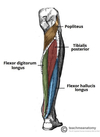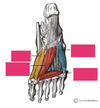Lower Limb Muscles Flashcards
What are the 2 groups of muscles in the gluteal region?
What are their functions?
Superficial muscles:
- they abduct and extend the femur
Deep muscles:
- they laterally rotate the femur
What are the superficial muscles in the gluteal region?
- Gluteus maximus
- Gluteus medius
- Gluteus minimus
- Tensor fascia lata
They act to abduct and extend the lower limb at the hip joint
What are the attachments, actions and innervation of gluteus maximus?
origin:
- gluteal surface of ileum, sacrum and coccyx
attachment:
- iliotibial tract and gluteal tuberosity of femur
actions:
- main extensor of the thigh
- assists in lateral rotation
innervation:
- inferior gluteal nerve
What are the attachments, actions and innervation of gluteus medius?
Origin:
- gluteal surface of the ilium
Insertion:
- greater trochanter of femur
actions:
- abducts and medically rotates the lower limb
- secures the pelvis and prevents pelvic drop during walking
innervation:
- superior gluteal nerve
What are the attachments, actions and innervation of gluteus minimus?
origin:
- ilium
insertion:
- greater trochanter
actions:
- abducts and medically rotates the limb
- prevents pelvic drop of the opposite limb during walking
innervation:
- superior gluteal nerve
What are the attachments, actions and innervation of the tensor fascia lata?
Origin:
- anterior superior iliac spine
Insertion:
- iliotibial tract, which attaches to the lateral condyle of the tibia
action:
- assists gluteus medius and gluteus minimus in abduction and medial rotation of the lower limb
innervation:
- superior gluteal nerve
What are the deep muscles of the gluteal region?
- Piriformis
- Superior and inferior gemelli
- Quadratus femoris
- Obturator internus
They laterally rotate the lower limb
What are the attachments, actions and innervation of piriformis?
Origin:
- anterior surface of the sacrum
insertion:
- travels through greater sciatic foramen
- Inserts into greater trochanter of femur
actions:
- lateral rotation and abduction
innervation:
- nerve to piriformis
What are the attachments, actions and innervation of obturator internus?
Origin:
- pubis and ischium at obturator foramen
insertion:
- travels through lesser sciatic foramen
- attaches to greater trochanter of femur
actions:
- lateral rotation and abduction
innervation:
- nerve to obturator internus
What are the attachments, actions and innervations of the gemelli?
origin:
- superior gemellus - ischial spine
- inferior gemellus - ischial tuberosity
insertion:
- greater trochanter of femur
actions:
- lateral rotation and abduction
innervation:
- superior gemellus - nerve to obturator internus
- inferior gemellus - nerve to quadratus femoris
What are the attachments, actions and innervation of quadratus femoris?
Origin:
- ischial tuberosity
insertion:
- quadrate tuberosity on the intertrochanteric crest
actions:
- lateral rotation
innervation:
- nerve to quadratus femoris
Label the muscles of the gluteal region


What is the innervation and general action of the muscles in the anterior compartment of the thigh?
Innervation:
- femoral nerve (L2-L4)
Action:
- extension of the leg at the knee joint
What are the muscles within the anterior compartment of the thigh?
- Pectineus
- Sartorius
- Quadriceps femoris
- Iliopsoas (the end passes into the anterior compartment)
What are the origins and insertions of iliopsoas?
Origin:
- Psoas major originates from the lumbar vertebrae
- iliacus originates from the iliac fossa
Insertion:
- lesser trochanter of femur
What are the actions and innervation of iliopsoas?
Actions:
- flexes the thigh at the hip joint
innervation:
- psoas major - anterior rami of L1-L3
- iliacus - femoral nerve
Label the muscles of the anterior thigh


What are the 4 muscles that make up quadriceps femoris?
- Rectus femoris
- Vastus lateralis
- Vastus medialis
- Vastus intermedius
What are the attachments, actions and innervation of vastus lateralis?
Origin:
- greater trochanter and lateral lip of linea aspera
Insertion:
- Quadriceps tendon, which attaches to the patella
Action:
- extends the knee joint and stabilises the patella
Innervation:
- femoral nerve
What are the attachments, actions and innervation of vastus medialis?
Origin:
- intertrochanteric line and medial lip of linea aspera
Actions:
- extends the knee joint and stabilises the patella
Innervation:
- femoral nerve
What are the attachments, actions and innervation of vastus intermedius?
Origin:
- anterior and lateral surfaces of femoral shaft
Actions:
- extends the knee joint and stabilises the patella
Innervation:
- femoral nerve
What are the attachments, actions and innervation of rectus femoris?
Origin:
- Ilium (just superior to acetabulum)
actions:
- flexes the thigh at the hip joint
- extends the leg at the knee joint
Innervation:
- femoral nerve
What are the attachments, actions and innervation of sartorius?
Origin:
- anterior superior iliac spine
Insertion:
- superior, medial surface of the tibia
Actions:
- flexes, abducts and laterally rotates the hip
- flexes the knee joint
Innervation:
- femoral nerve
Label the muscles


What is meant by pectineus being a “transitional muscle”?
it has a dual innervation
it is a transitional muscle between the anterior and medial thigh compartments
What is the passage of sartorius like?
it is long and thin and runs across the thigh in an inferomedial direction
it is more superficial than the other muscles in the leg
What are the attachments, actions and innervation of pectineus?
Origin:
- pectineal line on anterior surface of pelvis
Insertion:
- Pectineal line on posterior femur (just inferior to lesser trochanter)
Actions:
- adduction and flexion at the hip joint
Innervation:
- femoral nerve
- also receives a branch from the obturator nerve
Label the prosection image


What are the 5 medial thigh muscles?
What is their artery and nerve supply?
The ‘hip adductors’
- Gracilis
- Obturator externus
- Adductor brevis
- Adductor longus
- Adductor Magnus
They are supplied by the obturator nerve and obturator artery
Label the muscles of the medial thigh


What are the attachments of the 2 parts of the adductor Magnus muscle?
Adductor part:
- originates from inferior rami of pubis and rami of ischium
- attaches to linea aspera
Hamstring part:
- orginates from ischial tuberosity
- attaches to adductor tubercle and medial supracondylar line of the femur
What are the actions and innervation of adductor magnus?
Actions:
- adduction of the thigh
- the adductor part also flexes the thigh
- the hamstring portion also extends the thigh
Innervation:
- ‘adductor part - obturator nerve (L2-L4)
- hamstring part - sciatic nerve (L4-S3)
What are the attachments, innervation and actions of adductor longus?
Origin:
- originates from the pubis and expands into a fan shape
Insertion:
- linea aspera of femur
Innervation:
- obturator nerve (L2-L4)
Why can the adductor brevis be used as an anatomical landmark?
it lies between the anterior and posterior divisions of the obturator nerve
What are the attachments, actions and innervation of the adductor brevis?
Origin:
- body of pubis and inferior pubic rami
Insertion:
- Linea aspera of femur
- proximal to adductor longus
actions:
- Adduction of the thigh
Innervation:
- obturator nerve (L2-L4)
What are the attachments, innervation and actions of obturator externus?
Origin:
- membrane of obturator foramen and adjacent bone
Insertion:
- posterior aspect of greater trochanter
Actions:
- adduction and lateral rotation of the thigh
Innervation:
- Obturator nerve (L2-L4)
What are the attachments and passage of gracilis?
Originates from the inferior ramus of the pubis and body of the pubis
descends vertically down the leg to attach to the medial surface of the tibia
it attaches between the tendons of sartorius (anteriorly) and semitendinosus (posteriorly)
What are the actions and innervation of gracilis?
Actions:
- adduction of the thigh at the hip
- flexion of the leg at the knee
Innervation:
- obturator nerve (L2-L4)
Label the medial thigh muscles


What are the muscles in the posterior compartment of the thigh?
The Hamstrings
- Biceps femoris
- Semitendinosus
- Semimembranosus























